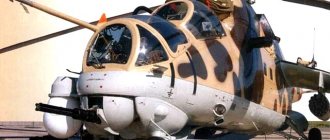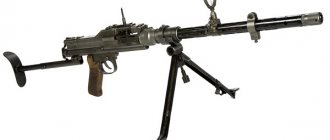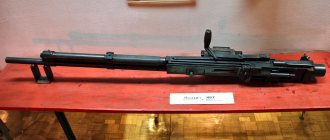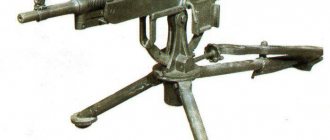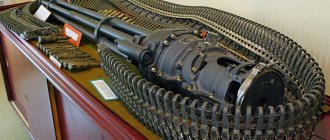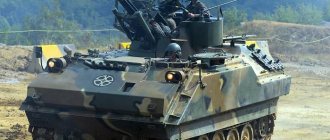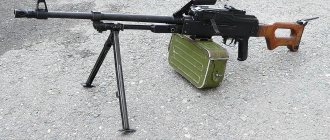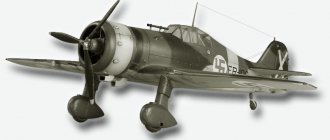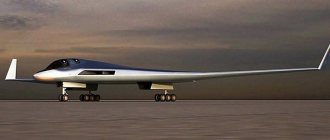For decades, one of the few examples of rapid-fire weapons was the Gatling gun. This cumbersome multi-barreled system with manually operated automation was used with varying success in various wars of the second half of the 19th century, and was quickly replaced by Maxim machine guns.
But the Gatling system was revived already in the middle of the 20th century, when the need arose to create aircraft and anti-aircraft guns with ultra-high rates of fire. One of the first Gatlings of the new generation was the 20mm M61 Vulcan cannon. For more than 50 years, it has remained the weapon of most American combat aircraft.
Prototype invented by Gatling
It was in 1862, when an American inventor named Gatling received his patent. The document confirming priority was about a firing system that fired up to two hundred bullets per minute. The principle of operation was the rotation of a block that included six barrels arranged in a circle in such a way that after each shot the next cartridge ended up at the next muzzle channel, while there was only one breech. Muscular force was used to rotate 60 degrees. At its core, it was a six-barreled revolver-type machine gun with an axis of rotation parallel to the line of fire, with the difference that instead of feeding the cartridge to the barrel, on the contrary, the barrel was fed to the cartridge. Well, it’s hard to deny the elegance of the technical solution to the author of the invention, although soon weapon designers abandoned this method of moving ammunition, preferring belt and disk magazines, which ensured a higher rate of fire and ease of reloading. Even the improvement of the Gatling model in 1866 provided only a slight improvement in performance. The system continued to remain cumbersome, however, this did not prevent it from being in service with the US Army until the beginning of the 20th century.
Descriptions and characteristics of the weapon
Mark 15 Phalanx CIWS Mod 0 design
On the ZAK Mark 15 Phalanx, automatic guidance of a gun mount with a “closed control loop” was implemented for the first time, in which the probability of shells hitting the target is greater than when targeting “with an open control loop.”
The essence of the new guidance method is that during firing the complex simultaneously determines the location of the target and projectiles along their flight path in relation to the target. If the direction to the target and the flight trajectory of the projectiles do not coincide, the system automatically adjusts the generated firing data in order to direct the projectiles exactly to the target. In “open-loop” systems, widely used in the navies of different countries, fire control devices continuously determine the target’s movement parameters. Based on them, initial data for shooting are developed, which are not adjusted. The probability of hitting a target in this case depends on the accuracy of the fire control system and taking into account all initial shooting corrections.
The Mark 15 Phalanx anti-aircraft artillery complex, developed by the American, is an all-weather automatic weapon system that provides autonomous search and detection of targets in a designated firing sector, assessment of the degree of their threat, selection of the most dangerous target, capture, tracking and determination of parameters of its movement, opening fire, automatic adjustment of firing in a closed loop, ceasefire and acquisition of a new target. The complex consists of two functional subsystems with a modular design (gun mount and radar fire control subsystem). Five modules (M61A1 gun with a magazine, a rotary machine with guidance mechanisms and a base, a barbette, radar antennas with servos under a radio-transparent cover and a rack with cells for a computerized fire control system.
All this is mounted in one compact block with a height of 4.7 m, occupying an area of 5.5 m2 on the ship’s deck. The complex also includes a remote control subsystem with a remote control and display devices installed at the ZAK operator's station.
Ammunition
Initially, two types of projectiles were developed for the Vulcan cannon: the armor-piercing incendiary M53 and the high-explosive fragmentation M56. The first is a simple steel blank with an aluminum ballistic tip, weighing 100 grams. The incendiary composition is located between the steel body and the aluminum tip. Initial speed – 1030 m/s. The high-explosive fragmentation projectile is loaded with 10 grams of explosive (“composition B”), the damage radius is estimated at 2 meters.
The M246 projectile was developed for anti-aircraft guns. It is distinguished by the presence of a self-liquidator. Since the end of 1980, “semi-armor-piercing” shells such as PGU-28 or M940 began to spread. Their difference is a body made of heat-strengthened steel and the absence of a fuse as such.
When a cannon shell hits a target, the incendiary composition ignites, and its flash detonates the explosive charge. Due to the slow action of this process and the durable casing, the projectile explodes inside the target. Armor penetration - about 12 mm at a distance of 500 meters.
The Mk.149 projectile is a sub-caliber projectile, with a detachable tray. The core was originally made from depleted uranium. Later, tungsten carbide was used for this purpose. The Mk.244 projectile has an increased core mass.
Processor models
GIGABYTE GA-M61PME S2 Rev 2.0 processor types supported are for AM2, AM2+ and AM3 computer platforms. This list includes the following chip families:
- Semtron's most cost-effective, low-speed solutions.
- The middle segment in this case was filled with devices from the Athlon and Athlon II lines. Such CPUs had 2, 3 or 4 cores and provided greater performance compared to Septron devices.
- Representatives of the Phenom and Phenom II series were considered premium microprocessors. Their key difference from the previous two families is the presence of a third level of fast cache and a larger number of computing modules. Accordingly, their productivity was an order of magnitude higher.
Nominally, it is quite possible to install any of the previously mentioned chips into this motherboard. But based on its technical specifications, it is most optimal to use only the first two families of microprocessors in combination with it. But for more expensive CPU models, more functional devices were developed, the price of which was significantly higher.
History of creation
The first jet fighters of the US Air Force retained the weapon system characteristic of American piston aircraft - a battery of six 12.7mm Browning machine guns. War experience, however, showed that “cannon” aircraft could hit the enemy from a greater range. At that time, the only aircraft cannon in the United States was a licensed copy of the 20mm HS.404 weapon, and its rate of fire was insufficient for promising aircraft.
One of the options for solving the problem of creating a rapid-firing automatic cannon was a revolving design. Another option involved the revival of the seemingly irrevocably outdated Gatling system. Although Dr. Gatling himself pointed out the prospects for the development of his brainchild, who in 1893 patented a version of a machine gun in which the barrels rotated using an electric motor.
At that time, finding a source of electricity to power weapons was possible only on ships, but in the mid-20th century this was no longer a problem.
The caliber was initially supposed to be increased slightly - to 15mm. It was believed that high initial speed and rate of fire would ensure sufficient efficiency even with this caliber. The first firing using the 15mm Vulcan prototype (under the symbol T45) took place in 1949, and a rate of 2500 rounds per minute was developed.
In 1950, the figure rose to 4,000 shots. But then the task changed - they decided that the 15mm caliber would no longer be enough, and decided to increase it. By 1952, the T171 and T150 were prepared - guns of 20 and 27 mm caliber, respectively. As a result, the 20mm gun was considered more balanced.
The first aircraft to carry the T171 cannon, later renamed the M61, was the F-104 Starfighter. And already during trial operation, unreliability of power supply was revealed. The links of the cartridge belt thrown out could damage the aircraft, and feeding a shot into the chamber was accompanied by failures. The modernized gun with a linkless shot feed received the M61A1 designation and found application not only on fighters.
Application
The first aircraft armed with the M61 Vulcan cannon entered service at the end of the 50s. They were the F-104 fighter, the F-105 fighter-bomber, and the gun appeared on the B-52 and B-58 bombers as a defensive weapon. And then senior Air Force officials decided that the rapid development of guided missiles would make guns unnecessary, and new aircraft were designed without built-in weapons.
The Vietnam War showed the fallacy of such conclusions. Armed with the Vulcan, the F-105, even after firing all its missiles, could successfully fight off the North Vietnamese MiG-17s.
But the newest “Phantoms” turned out to be helpless in such situations. As a temporary solution to this problem, the SUU-16/Ac suspended container with an M61 cannon and 1200 shells was developed for the Phantoms. The rotor of the gun in it was spun by the incoming air flow. An improved model with a gun without external power was designated SUU-23/A. Sometimes up to 5 such containers were hung on the Phantoms.
Late-model Phantoms and next-generation fighters once again received the built-in Vulcan.
During the Vietnam War, 39 North Vietnamese fighters were shot down using M61 cannons.
In 1967, the M167 anti-aircraft gun, armed with the Vulcan, was adopted, and in 1969, the M163 self-propelled anti-aircraft gun on the M113 armored personnel carrier chassis. Both anti-aircraft guns were considered a temporary measure, but failures in the development of a more advanced system led to the fact that the Vulcan anti-aircraft guns remained in service until the 90s, and are still used locally.
In 1980, the US Navy received the Phalanx anti-aircraft complex, armed with the M61 cannon and designed to protect ships mainly from anti-ship missiles. In 2004, its ground version, the Centurion, appeared, knocking down shells and mortar mines with cannon fire.
Automatic device - clock Nerf Vulcan
A student from Germany, Michelson, using the popular toy blaster gun Nerf of the Vulcan system, designed a rather funny, but very useful automatic device, perfect for protecting the area.
With the help of several additional drives, conventional electronics and computer programs, the Nerf guard weapon can automatically recognize, track a target, and then hit it. With all this, the owner of the weapon can be in shelter.
The trigger mechanism of the mechanized Nerf Vulcan device is connected to a laptop and hardware-software (integrated circuit) Arduino Uno with processors. It is triggered when a web camera tracking and scanning the area around it detects the movement of an unnecessary object. In this case, the webcam is installed on the front panel of the laptop, and the computer program is configured for movement.
The idea of multi-barreled rapid-fire weapons arose in the 15th century and was embodied in some samples of that time. Despite its obvious advantages, this type of gun did not catch on and was, rather, an exotic illustration of the development of design ideas than a real effective firing system.
In the 19th century, inventor R. Gatling from Connecticut, who worked on agricultural machinery and later became a doctor, received a patent for a “revolving battery gun.” He was a kind man and believed that, having received such a terrible weapon, humanity would come to its senses and, fearing the numerous victims, would stop fighting altogether.
The main innovation in the Gatling gun was the use of gravity to automatically feed cartridges and extract cartridges. The naive inventor could not have imagined that his brainchild would become the prototype of a super-fast-firing machine gun in the middle and second half of the 20th century.
The development of technical thought after the Korean War led to the emergence of new weapons for aviation. The rapid speeds of the MiGs and Sabers left the pilots too little time for careful aiming, and the number of cannons and machine guns could not be very large. The rate of fire was limited by the fact that the barrels overheated. The way out of this engineering impasse was the six-barreled Vulcan M61 machine gun, which arrived just in time for a new massacre, the Vietnam War.
With each passing decade, the duration of combat contact between opponents is decreasing. The one who managed to fire more charges and started shooting first has a better chance of surviving. Mechanical devices simply cannot cope in such an environment, so the Vulcan machine gun is equipped with an electric drive with a power of 26 kW, which rotates the barrels that fire 20-mm projectiles in turn, as well as an electric system for igniting the capsules. This solution allows firing at a speed of up to 2000 rounds per minute, and in “turbo” mode – 4200.
The Vulcan machine gun is quite massive and is intended primarily for aviation, although it can also be used in ground-based air defense systems. Initially it was installed on Lockheed Starfighters, but later they began to equip it on A-10 attack aircraft. It was also suspended under the fuselage of the Phantom F-4 as an additional artillery container, after it became clear that missiles alone could not be used in maneuverable air combat. Weight of 190 kg is no joke, and this is without ammunition, which at such a rate of fire requires a considerable amount, so children's toys, the Vulcan nerf machine gun, which shoots arrows, have little in common with the prototype.
This weapon is relatively easy to maintain; the design is made as practical as possible. To load the Vulcan machine gun, you need to remove it, but this is easy to do. Problems arose in the 50s, when survey work was carried out. A large number of projectiles create powerful recoil, which resulted in difficulties with piloting.
In the USSR, the creation of multi-barreled aircraft weapons began a good ten years later than in the United States. The answer to the Vulcan machine gun was the 6K30GSh, AK-630M-2 anti-aircraft automatic guns and other types of artillery installations with a high density of fire. Some improvements in the creation of initial and operating torques provide certain technical and operational advantages, but the design is based on the same Gatling principle.
Specifications
Let’s compare the Vulcan with some of its “contemporaries” - the Soviet GSh-23 cannon and the British ADEN.
When developing a new aircraft gun, the British relied on the power of a single projectile. The relatively low rate of fire was compensated for by the installation of several guns. The Soviet cannon is inferior to the M61 in rate of fire and initial projectile velocity, but is slightly superior in its mass.
As the main weapon of fighters, unlike the Vulcan, competitors did not stay long - late Soviet aircraft received 30mm cannons, and in Europe the 27mm Mauser cannon became widespread. Interestingly, all three guns are made according to different designs. The ADEN system is built on a revolver design, and the GSh-23 uses a Gast design, in which one barrel is reloaded at the moment the second is fired.
She also managed to demonstrate that the design of a weapon with a rotating barrel block is not at all outdated and can compete on equal terms with more modern developments.
Design and modifications
M61 is a multi-barrel gun with a rotating barrel block. The design of the gun, despite the number of barrels, is quite simple. Each of the Vulcan's six barrels has its own bolt and chamber.
The bolts are moved using rollers attached to them, which move along a special groove in the receiver.
Locking the barrels is done by turning the bolt cylinder. The ignition of the cartridge case is electrical. The automation of the basic modification of the Vulcan operates due to an external drive from the hydraulic system of the carrier aircraft. On other versions, the barrel block could be spun by an electric motor from the on-board network.
Modifications
The barrel drive system may vary depending on the modification, but in most cases it is external, hydraulic.
M61A2 is a lightweight version installed on later F/A-18s. Due to thinner barrels and replacement of metal parts, the weight of the gun was reduced to 92 kg.
M130 (GAU-4) - “Vulcan”, which does not require external power. The block of barrels is rotated by the exhausted powder gases. This modification was used for installation in suspended cannon nacelles.
M197 is a three-barreled Vulcan with a rate of fire reduced to 1500 rounds per minute. Intended to arm AH-1 Cobra attack helicopters.
M195 is a version designed for installation on helicopters with six shortened barrels. As a result, it was not accepted into service.
XM301 – the most lightweight “Vulcan” with two barrels, which was supposed to arm helicopters.
M168 – cannon for anti-aircraft artillery installations.
Even more famous than the above-mentioned Vulcan variants is the six-barreled M134 Minigun machine gun of 7.62mm caliber, designed for arming helicopters. This is, in fact, a smaller version of the M61 cannon.
On target, but not right away
Despite the fact that the product, which received the AO-19 index, was practically ready, there was no place for it in the Soviet Air Force, since the military themselves believed that small arms were a relic of the past, and missiles were the future. Shortly before the Air Force rejected the new gun, Vasily Gryazev was transferred to another enterprise. It would seem that the AO-19, despite all the unique technical solutions, will remain unclaimed.
But in 1966, after summarizing the experience of the North Vietnamese and American Air Forces in the USSR, it was decided to resume work on the creation of promising aircraft guns. True, by that time almost all enterprises and design bureaus that had previously worked on this topic had already reoriented themselves to other areas. Moreover, there were no people willing to return to this line of work in the military-industrial sector!
Surprisingly, despite all the difficulties, Arkady Shipunov, who by this time headed TsKB-14, decided to revive the cannon theme at his enterprise. After the Military-Industrial Commission approved this decision, its management agreed to return Vasily Gryazev, as well as several other specialists who took part in the work on the “AO-19 product,” to the Tula enterprise.
As Arkady Shipunov recalled, the problem of resuming work on cannon aircraft weapons arose not only in the USSR, but also in the West. In fact, at that time, the only multi-barreled gun in the world was the American one - the Vulcan.
It is worth noting that, despite the rejection of the “AO-19 object” by the Air Force, the product was of interest to the Navy, for which several gun systems were developed.
By the beginning of the 70s, KBP offered two six-barreled guns: the 30-mm AO-18, which used the AO-18 cartridge, and the AO-19, chambered for 23-mm AM-23 ammunition. It is noteworthy that the products differed not only in the projectiles used, but also in the starters for preliminary acceleration of the barrel block. The AO-18 had a pneumatic one, and the AO-19 had a pyrotechnic one with 10 squibs.
Initially, representatives of the Air Force, who considered the new gun as armament for promising fighters and fighter-bombers, placed increased demands on the AO-19 for firing ammunition - at least 500 shells in one burst. I had to seriously work on the survivability of the gun. The most loaded part, the gas rod, was made of special heat-resistant materials. The design has been changed. The gas engine was modified, where so-called floating pistons were installed.
Preliminary tests have shown that the modified AO-19 can show much better performance than originally stated. As a result of the work carried out at the KBP, the 23-mm cannon was able to fire at a rate of fire of 10–12 thousand rounds per minute. And the mass of the AO-19 after all the modifications was just over 70 kilograms.
For comparison: the American Vulcan, which had been modified by this time, received the index M61A1, weighed 136 kilograms, fired 6000 rounds per minute, the salvo was almost 2.5 times smaller than that of the AO-19, while American aircraft designers also needed to place on board The aircraft also has a 25-kilowatt external electric drive.
And even on the M61A2, which is on board the fifth-generation fighter F-22, American designers, with the smaller caliber and rate of fire of their guns, were unable to achieve the unique indicators in weight and compactness, like the gun developed by Vasily Gryazev and Arkady Shipunov.
Birth of a legend
The first customer of the new AO-19 gun was the Sukhoi Experimental Design Bureau, which at that time was headed by Pavel Osipovich himself. Sukhoi planned that the new gun would become armament for the T-6, a promising front-line bomber with variable wing geometry, which they were then developing, which later became the legendary Su-24.
The time frame for work on the new vehicle was quite tight: the T-6, which made its first flight on January 17, 1970, in the summer of 1973, was already ready for transfer to military testers. When fine-tuning the AO-19 to the requirements of aircraft manufacturers, certain difficulties arose. The gun, which fired well on the test bench, could not fire more than 150 shots - the barrels overheated and needed to be cooled, which often took about 10–15 minutes, depending on the ambient temperature.
Another problem was that the gun did not want, as the designers of the Tula Instrument Engineering Design Bureau joked, “to stop shooting.” After releasing the launch button, the AO-19 managed to spontaneously fire three or four projectiles. But within the allotted time, all the shortcomings and technical problems were eliminated, and the T-6 was presented to the Air Force GLITs for testing with a gun fully integrated into the new front-line bomber.
During the tests that began in Akhtubinsk, the product, which by that time had received the GSh index (Gryazev - Shipunov) -6-23, was shot at various targets. During the test use of the newest system, in less than one second, the pilot was able to completely cover all targets, firing about 200 shells!
Pavel Sukhoi was so satisfied with the GSh-6-23 that, along with the standard Su-24 ammunition, the so-called SPPU-6 suspended gun containers with movable GSh-6-23M gun mounts, capable of deflecting horizontally and vertically by 45 degrees, were included . It was assumed that with such weapons, and in total it was planned to place two such installations on the front-line bomber, it would be able to completely disable the runway in one pass, as well as destroy a column of motorized infantry in combat vehicles up to one kilometer long.
Developed at SPPU-6 it became one of the largest mobile cannon installations. Its length exceeded five meters, and its mass with ammunition of 400 shells was 525 kilograms. The tests showed that when firing with the new installation, there was at least one projectile hit per linear meter.
It is noteworthy that immediately after Sukhoi, the Mikoyan Design Bureau became interested in the cannon, which intended to use the GSh-6-23 on the latest supersonic interceptor MiG-31. Despite its large size, aircraft manufacturers required a fairly small-sized gun with a high rate of fire, since the MiG-31 was supposed to destroy supersonic targets. KBP helped Mikoyan by developing a unique lightweight conveyor-free linkless feeding system, thanks to which the weight of the gun was reduced by several more kilograms and gained additional centimeters of space on board the interceptor.
Developed by outstanding gunsmiths Arkady Shipunov and Vasily Gryazev, the GSh-6-23 automatic aircraft gun still remains in service with the Russian Air Force. Moreover, in many ways its characteristics, despite its more than 40-year service life, remain unique.
Story
At the end of World War II, the United States began research into creating more effective cannon weapons for jet fighters. Due to increased flight speeds, faster-firing guns were required. In Germany, samples of single-barreled revolving guns (Mauser MG 213) were captured that had a high rate of fire, which was nevertheless limited by the cartridge supply system, overheating and barrel wear. The US Air Force needed more effective guns, and General Electric Armament Division began developing a multi-barrel gun using the old Gatling design. The original Gatling gun was not widely used due to the high power consumption of the barrel block rotation drive, but jet fighters of the late 1940s had powerful electrical and hydraulic systems, which made it possible to use multi-barrel guns on them. Multi-barreled guns, compared to revolving ones, have a lower rate of fire per barrel, but a higher rate for the entire cannon installation.
The US Air Force contracted with General Electric in 1946 to develop Project Vulcan, a six-barrel cannon with a rate of fire of 6,000 rounds per minute. In Europe, after World War II, 30 mm guns with more powerful projectiles became widespread; in the USA, it was decided to use 20 mm guns, which had less mass but a higher rate of fire and muzzle velocity. First prototype gun mount, T-171
, was created by General Electric in 1949.
In 2009, the US Air Force adopted the M61 Vulcan aircraft gun chambered for a 20 mm 20x102 mm cartridge with electric capsule ignition. The M61 is a six-barreled hydraulically driven gun with two fire modes: 4000 and 6000 rounds/min. During testing of the F-104 Starfighter supersonic fighter, a number of difficulties and failures were identified associated with the 20-mm T171 Vulcan cannon mount. Difficulties were caused by delays in the link supply system for cartridges, and the danger posed by individual links. For the modernized version of the M61A1 gun, a linkless cartridge supply system was developed. The M61A1 gun later became the standard armament of American fighters.
Ammunition for the gun is manufactured at the Olin Ordnance plant in St. Petersburg, Florida.
Background of development
Mark 15 Phalanx CIWS Mod. 1A during shooting.
For a long time, anti-aircraft artillery mounts were used as the main means of air defense on ships. With the increase in speed and the use of jet propulsion in aviation, the use of artillery systems became ineffective. Subsequently, priority in air defense systems was given to anti-aircraft missile systems (SAM). With the development of rapid-fire artillery, radar equipment and fire-correction equipment, as well as to combat transonic anti-ship missiles (ASM), the use of gun mounts in air defense systems has become relevant.
As the experience of combat operations, as well as research, has shown, in order to disrupt an attack by an anti-ship missile flying at low altitude, it is necessary to detonate its warhead at a distance of at least 1000 m from the ship, which will not allow the missile to reach the target if the system is disabled control, propulsion system, etc.
Small caliber artillery mounts, compared to large and medium caliber mounts, have higher firing accuracy, a significant rate of fire, higher horizontal and vertical guidance speeds, and shorter reaction times. They provide the maximum number of projectile hits on a low-flying anti-ship missile for its reliable destruction, as well as a flat trajectory of the projectiles and their high initial speed.
The first prototype of the Mark 15 Phalanx CIWS aboard USS KING (DLG-10/DDG-41) during testing.
In addition, artillery mounts can have ammunition rounds, allowing them to repel a large number of attacking air targets. As mentioned above, in order to destroy an anti-ship missile, it is necessary to ensure that projectiles directly hit its warhead, which is usually located in a protected compartment behind the homing head. This circumstance required the creation of armor-piercing sub-caliber ammunition with high kinetic energy.
Links
- https://army-news.ru/2012/10/zenitnyj-artillerijskij-kompleks-falanks/
- https://fas.org/man/dod-101/sys/ship/weaps/mk-15.htm
- https://www.dogswar.ru/artilleriia/zenitnye-kompleksy/1290-zenitnyi-artilleriis.html
- https://www.answers.com/topic/phalanx-ciws
- https://eumenesofcardia.deviantart.com/art/Phalanx-20mm-CIWS-Final-with-Textures-360143408
- https://edtech.mcc.edu/~genglish/comw100/Final%20Project/design.html
- https://www.navweaps.com/index_tech/tech-103.htm
- https://chvvakush.ru/vsig/veroyatnyj-protivnik/sistema-oruzhiya-blizhnego-boya-mk-15-phalanx-ciws
Design features of the M61 Vulcan gun
M61 Vulcan is a six-barreled aircraft machine gun (cannon) with an air-cooled barrel and ammunition with a 20 x 102 mm cartridge with an electric capsule ignition type.
custom_block(1, 80009778, 1555);
The ammunition supply system for the six-barreled Vulcan machine gun is without a link, from a cylindrical magazine with a capacity of 1000 rounds. The machine gun and the magazine are connected by two conveyor feeds, in which the spent cartridges are returned back to the magazine using a returnable assembly flow.
Conveyor belts are located in elastic guide sleeves with a total length of 4.6 meters.
The entire array of cartridges in the magazine moves along its axis, but only the central guide rotor, made in the shape of a spiral, rotates, between the turns of which the ammunition is placed. When firing, two cartridges are synchronizedly removed from the magazine, and two spent cartridges are placed in it on the reverse side, which are then placed on the conveyor.
The firing mechanism has an external drive circuit with a power of 14.7 kW.
This type of drive does not require the installation of a gas regulator and is not afraid of misfires.
custom_block(1, 70988345, 1555);
The ammunition load can be: caliber, fragmentation, armor-piercing incendiary, fragmentation incendiary, sub-caliber.
What about us?
Soviet gunsmiths closely followed the achievements of their American colleagues, but preferred to act in their own way. It was considered unnecessary to copy a six-barreled machine gun in the USSR. The GSh-23 cannon (the number is the caliber in mm) is half the weight of the Vulcan, and it can fire up to 3-4 thousand rounds per minute, which is usually quite enough. There is also a heavier 30-mm version of the GSh-30, which is armed with Su-25 aircraft and Mi-24P helicopters. By the way, both guns are double-barreled.
Domestic gunsmiths used rotating blocks in the design of the YakB-12.7 and GshG-7.62 machine guns (the numbers mean the same thing), but in this case there are fewer barrels - only four. And finally, about the six-barreled Soviet GSh-6-23 cannons, developed for the Mig-27 and the AK-230 and AK-630 shipborne anti-aircraft systems. Their rate of fire is slightly higher than Vulcan's - it is 10 thousand rounds/min.
By the way, domestic systems do not require an external power source; the rotation of the barrel blocks is carried out by the energy of the powder gases.
References[edit | edit source]
- ↑ “M61 20mm cannon”. Federation of American Scientists. 23 April 2000. https://www.fas.org/man/dod-101/sys/ac/equip/m61.htm. Retrieved 2009-02-28.
- ↑ “Elec key Gatling” (JPEG). Image shack. https://img294.imageshack.us/img294/2433/eleckeygatling.jpg..
- Wahl, Paul F; Toppel, Donald R (5 Oct 2005). "The Gatling Gun". Aircraft Armament & Small Arms Product Support Integration Directorate. Archived from on 2008-09-21. https://web.archive.org/web/20080921095536/https://tri.army.mil/LC/CS/csa/aagatlin.htm. Retrieved 2008-09-28.
- ↑ Air Force Manual 11W1-12-4-32
- "Projects". “...features new lightweight gun system is the General Dynamics M61A2, which has a switchable firing rate of 4,000 or 6,000 shots per minute and a fully integrated linkless ammunition feed system”
- “PGU-27A/B TP/PGU-28A/B SAPHEI/ GU-30A/B TP-T.” Global Security. https://www.globalsecurity.org/military/systems/munitions/pgu-28.htm. Retrieved 2008-09-28.
- (PDF) Ammunition Active (Report). Airborne Weapons Corrective Action Program. 30 November 2001. pp. 1–6. 14597. Archived from the original on October 17, 2004. https://web.archive.org/web/20041017182625/https://tercel.mugu.navy.mil/drlog/awcap/volumes/vol8/ammo/v348_prob.pdf .
- ↑ “20-Millimeter”. Air cav. 12 January 2008. https://www.aircav.com/cobra/ammo20.html.
- ↑ “ORDATA: Ordnance Identification Tool”. J.M.U. Archived from the original on August 19, 2014. https://web.archive.org/20140819195104/https://maic.jmu.edu:80/ordata/.
- “PGU-27A/B TP/PGU-28A/B SAPHEI/PGU-30A/B TP-T.” Global Security. July 7, 2011. https://www.globalsecurity.org/military/systems/munitions/pgu-28.htm. Retrieved 2010-01-25.
- Toperczer (MiG-17/MiG-19 Units) p. 65
- Hobson p. 17
- Anderton p. 71
- Toperczer (MiG-17/MiG-19 Units) pp. 30, 31, 88
- McCarthy Jr. p. 38, photo of 23mm cannon exit hole on Maj. Tracy's F-105
- Michel III p. 56
- ↑ Chant, Christopher (1987). A Compendium of Armaments and Military Hardware
. Routledge. pp. 65–70, 106, 114–15, 341–43, 363, 389, 404–5. ISBN 978-0-7102-0720-3. https://books.google.com/?id=k9cNAAAAQAAJ&pg=PA115. - McCarthy Jr. pp. 148–57. Excludes combination air-to-air missile/gun kills.
- McCarthy Jr. p. 38
- Campbell & Hill p. 43/photo of his F-105 plate #213
- Davies, Osprey #45, p. 86
- Michel III pp. 181, 267
- Davies, Osprey #55, pp. 37–38
Toys and movies
The six-barreled monster just begs to be taken into the hands of a Hollywood blockbuster hero, but this directorial move is due only to wild imagination. Even if we discard such a convention as the need for a power source (27V, 400A, which in terms of power that everyone understands is 4 hp), then there is still a lot of ammunition left, which is about 25 kg per minute. And even the recoil... In general, the Vulcan is as useful in your hands as a pie in the sky.
But there is no need to despair, there is always a place for heroism in life. You can simply buy a Vulcan nerf gun (usually sold in the toys and sports accessories department)
And, of course, the developers of computer shooting games did not ignore the M61 either.
Observations
This galaxy is part of the famous cluster of galaxies in the constellation Virgo. The appearance of the spiral galaxy M61 is in many ways similar to that of our galaxy. When observed through an amateur telescope, Messier 61 appears as a rounded, nebulous speck that brightens toward the center. To clearly identify the core in the galaxy, as well as to examine the spiral arms, you will need a telescope with an aperture of more than 250 - 300 mm.
Spiral galaxy M61 on degree scales
Spiral galaxy M61 can be found three degrees north of Eta (η) Virgo. Also, if you draw an imaginary line between the stars Beta and Delta Virgo and highlight the middle of the segment, then you can find the object Messier 61 a degree north of it.
Galaxy Messier 61 in the constellation Virgo
The main tactical and technical properties of the Vulcan M61
- The total length of the gun is 1875 mm.
- Barrel length – 1524 mm.
- The mass of the M61 Vulcan gun is 120 kg, with a set of feed systems (without cartridges) – 190 kg.
- Rate of fire – 6000 rounds/min. Instances with a firing rate of 4000 rounds/min were produced.
- The initial speed of caliber/sub-caliber projectiles is 1030 / 1100 m/s.
- Muzzle power – 5.3 MW.
- The time to reach the highest rate of fire is 0.2 - 0.3 seconds.
- Vitality - about 50 thousand shots.
The Vulcan M61 rapid-fire submachine gun is currently installed on fighters - Eagle (F-15), Corsair (F-104, A-7D, F-105D), Tomcat (F-14A, A- 7E), "Phantom" (F-4F).
Operational Use
The gun takes about 0.3 seconds to wind up to the full rate of fire, and half a second to wind down again. Some critics (notably defense analyst Pierre Sprey in a paper called First Rounds Count
) argue that the aim is at it truest when the pilot pulls the trigger, and that it starts wandering off almost immediately.
A close-up of the gunport of a Dutch F-16B after a live-firing exercise. Hot gases from the muzzle have left carbon traces, which -if not removed- corode the paint. (F-16.net photo)
Close up of the M61 gunport on a Norwegian F-16A. The copper color is copper-grease, applied to the gunport to protect it from the hot gases during firing. Burns from the gases are difficult to clean after a firing period. (F-16.net photo)
Therefore, the 0.3 seconds delay would cause the gun to fire just after
the piper was best aligned with the target. A revolver cannon such as the Mauser BK27 (fitted in the Tornado) does not have this problem, as it reaches its maximum rate of fire instantly. A simple calculation however shows that the M61 fires 70 rounds in the first second (6,000 rounds/minute = 100/second. 30% of the first second is wasted on winding up, so that leaves 70 rounds fired in the first second). The BK27 fires at 1,700 rpm, or 28 rounds per second.
The rate of fire of 6,000 rpm or 100 rps means that shells are spaced by 0.01 sec. A MiG-29, with a length of 56ft 5in (17.20m) and 90? angle-off (ie with a direction of flight perpendicular to the direction of flight of the F-16), flying at 543kts (1,000 km/h) or 278m/sec travels 2.78m in 0.01 sec. Therefore, the Fulcrum will be hit at least 5-6 times if the aim is true (17.2/2.78=6.187).
